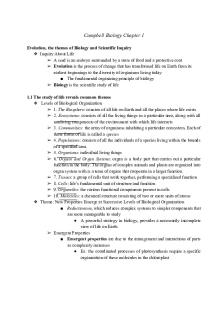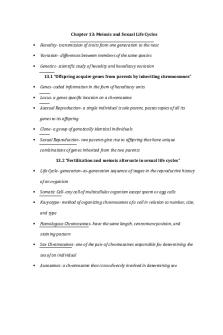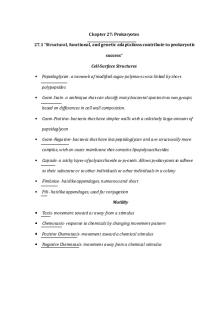Chapter 8 (campbell biology) PDF

| Title | Chapter 8 (campbell biology) |
|---|---|
| Course | Molecular Biology |
| Institution | Binghamton University |
| Pages | 8 |
| File Size | 610.3 KB |
| File Type | |
| Total Downloads | 97 |
| Total Views | 215 |
Summary
Notes on chapter 8 of the Campbell Biology Textbook. Very good for studying for an exam or for reading along to the textbook. Perfect for annotating along with the book!...
Description
Chapter 8: An Introduction to Metabolism - Metabolism: is the totality of an organism’s chemical reactions an emergent property of life that arises from interactions between molecules within the cell 8.1: An organism’s metabolism transforms matter and energy, subject to the laws of thermodynamics - metabolic pathway: begin with a specific molecule, which is then altered in a series of defined steps, resulting in a certain product each step of the pathway is catalyzed by an enzyme - catabolic pathways: release energy by breaking down complex molecules into simpler compounds - ie: cellular respiration: the breakdown of glucose in the presence of oxygen - anabolic pathways: consume energy to build complex molecules from simpler ones - ie: synthesis of protein form amino acids - bioenergetics: the study of how organisms manage their energy resources - energy: the capacity to cause change - can exist in various forms, some of which can perform work - energy can be converted from one form to another forms of energy ◆ kinetic energy: energy associated with motion ◆ heat (thermal) energy: kinetic energy associated with random movement of atoms or molecules ◆ potential energy: energy that matter possesses because of its location or structure ◆ chemical energy: potential energy available for release in a chemical reaction the laws of energy transformation ◆ thermodynamics: the study of energy transformations ● a closed system ○ example:liquid in a thermos- isolated from its surroundings ● in an open system ○ energy and matter can be transferred between the system and its surroundings (organisms are open systems)
1. the first law of thermodynamics (principle of the conservation of energy): - the energy of the universe is constant - energy can be transferred and transformed, but it cannot be created or destroyed 2. the second law of thermodynamics - during every energy transfer/transformation, some energy is unusable, and is often lost as heat - every energy transfer/transformation increase the entropy(disorder) of the universe - living cells unavoidably convert organized forms of energy to heat - spontaneous processes: occur without energy input; they can happen quickly or slowly - for a process to occur without energy input, it must increase the entropy of the universe Biological order and disorder ◆ cells create ordered structures from less ordered materials ◆ organisms also replace ordered forms of matter and energy with less ordered forms ◆ energy flows into an ecosystem in the form of light and exists in the form of heat ◆ the evolution of more complex organisms does not violate the second law of thermodynamics ◆ entropy may decrease in an organism, but them universes total entropy increases 8.2: The free-energy change of a reaction tells us whether or not the reaction occurs spontaneously - biologists want to know which reactions occur spontaneously and which require input of energy - in order to do that, they need to determine energy changes that occur in chemical reactions - Free-Energy Change, ΔG (Gibbs Free Energy) - free energy: the portion of a system's energy that can perform work when temperature and pressure and uniform throughout the system - any change from the equilibrium position will have a positive ΔG and will not be spontaneous - for a system in equilibrium, ΔG is at its lowest possible value in that system
ΔG= ΔH - TΔS Free energy= total energy- unusable energy -
-
only processes with a negative ΔG are spontaneous
Free Energy and Metabolism: - exergonic and endergonic reactions in metabolism - exergonic: “energy outward” - net release of free energy - endergonic: “energy inward” - absorbs free energy from its surroundings - Equilibrium and Metabolism - reactions in a closed system eventually reach equilibrium and them do no work - cells are not in equilibrium; they are open systems experiencing a constant flow of materials - a defining feature of life is that metabolism is never at equilibrium 8.3: ATP powers cellular work by coupling exergonic reactions to endergonic reactions - a cell does three main kinds of work 1. chemical: the pushing of endergonic reactions, which would not occur spontaneously, such as the synthesis of polymers from monomers 2. transport: the pumping of substances across membranes against the direction of spontaneous movement 3. mechanical: such as the beating of cilia, the contraction of muscle cells, and the movement of chromosomes during cellular reproduction - to do work, cells manage energy resources by energy coupling, the use of an exergonic process to drive an endergonic one
-
-
- most energy coupling cells is mediated by ATP the structure and hydrolysis of ATP: - ATP (adenosine triphosphate) : the cell’s energy shuttle - composed of ribose (sugar), adenins (nitrogenous base), and three phosphate groups - the bonds between the phosphate groups of ATP’s tail can be broken by hydrolysis - energy is released from ATP when the terminal phosphate bond is broken - this release of energy comes from the chemical change to a state of lower free energy, not from the phosphate bonds themselves - how the hydrolysis of ATP performs work - the 3 types of cellular work (mechanical, transport, chemical) are powered by the hydrolysis of ATP - in the cell, the energy from the exergonic reaction of ATP hydrolysis can be used to drive an endergonic reaction - the coupled reactions are exergonic - ATP drives endergonic reactions by phosphorylation, transferring a phosphate group to some other molecule (ie: a reactant) - the recipient molecule is now called a phosphorylated intermediate the regeneration of ATP: - ATP is a renewab;e resource that is regenerated by an addition of a phosphate group to ADP (adenosine diphosphate) - the energy to phosphorylate ADP comes from catabolic reactions in the cell - the ATP cycle is a revolving door through which energy passes during its transfer from catabolic to anabolic pathways
8.4: Enzymes speed up metabolic reactions by lowering energy barriers - catalyst: a chemical agent that speeds up a reaction without being consumed by the reaction - enzyme: a catalytic protein - hydrolysis of sucrose by the enzyme sucrase is an example of an enzyme-catalyzed reaction -
-
activation energy barrier: every chemical reaction between molecules involves bond breaking and bond forming - the initial energy needed to start a chemical reaction is called the free energy of activation or activation energy (EA) - activation energy is often supplied in the form of thermal energy that the reactant molecules absorb from their surroundings how enzymes lower the EA barrier - enzymes catalyze reactions by lowering the EA barrier - enzymes do not affect the change in free energy (ΔG); instead, they hasten reactions that would occur eventually
-
substrate specificity of enzymes - enzymes substrate: the reactant that an enzyme acts on
-
-
-
enzyme -substrate complex: when the enzyme binds to its substrate - active site: the region on the enzyme where the substrate binds - induced fit of a substrate brings chemical groups of the active site into positions that enhance their ability to catalyze the reaction catalysis in the enzyme’s active site - in an enzymatic reaction, the substrate binds to the active site of the enzyme - the active site can lower EA barrier by orienting substrates correctly - straining substrate bonds - providing a favorable microenvironment - covalently bonding to the substrate effects of local conditions on enzyme activity an enzymes activity can be affected by: 1. general environmental factors a. temperature and pH i. each enzyme has an optimal temperature and pH in which it functions ii. optimal conditions favor the most active shape for the enzyme molecule 2. chemicals that specifically influence the enzyme
-
-
cofactors: non protein enzyme helpers - may be inorganic, a metal in ionic form, or organic - coenzyme: an organic cofactor - coenzymes include vitamins enzyme inhibitors:
competitive inhibitors: bind to the active site of an enzyme competing with the substrate noncompetitive inhibitors: bind to another part of the enzyme, causing the enzyme to change shape and making the active site less effective ◆ examples of inhibitors : toxins, poisons, pesticides, antibiotics -
the evolution of enzymes: - enzymes are proteins encoded by genes - changes (mutations) in genes leads to changes in amino acid composition of an enzyme - altered amino acids in enzymes may alter their substrate specificity - under new environmental conditions, a novel form of an enzyme might be favored
8.5: Regulation of enzyme activity helps control metabolism chemical chaos would result if a cells metabolic pathways were not tightly regulated a cell does this by switching on or off genes that encode specific enzymes or by regulating the activity of enzymes - allosteric regulation of enzymes: allosteric regulation may either inhibit or stimulate an enzyme's activity ◆ occurs when a regulatory molecule binds to a protein at one site and affects the proteins function at another site allosteric activation and inhibition: ◆ most allosterically regulated enzymes are made from polypeptide subunits - each enzyme has active and inactive forms - the binding of an activator stabilizes the active form of the enzyme - the binding of an inhibitor stabilizes the inactive form of the enzyme - cooperativity: a form of allosteric regulation that can amplify enzyme activity
-
one substance molecule primes an enzyme to act on additional substrate molecules more readily cooperativity is allosteric because binding by a substrate to one active site affects catalysis in a different active site
feedback inhibition: ◆ the end product of a metabolic pathway shuts down the pathways ◆ prevents a cell from wasting chemical resources by synthesizing more products than is needed ...
Similar Free PDFs

Chapter 8 (campbell biology)
- 8 Pages

Campbell Biology Chapter 1
- 8 Pages

Ch26 - Summary Campbell Biology
- 6 Pages
Popular Institutions
- Tinajero National High School - Annex
- Politeknik Caltex Riau
- Yokohama City University
- SGT University
- University of Al-Qadisiyah
- Divine Word College of Vigan
- Techniek College Rotterdam
- Universidade de Santiago
- Universiti Teknologi MARA Cawangan Johor Kampus Pasir Gudang
- Poltekkes Kemenkes Yogyakarta
- Baguio City National High School
- Colegio san marcos
- preparatoria uno
- Centro de Bachillerato Tecnológico Industrial y de Servicios No. 107
- Dalian Maritime University
- Quang Trung Secondary School
- Colegio Tecnológico en Informática
- Corporación Regional de Educación Superior
- Grupo CEDVA
- Dar Al Uloom University
- Centro de Estudios Preuniversitarios de la Universidad Nacional de Ingeniería
- 上智大学
- Aakash International School, Nuna Majara
- San Felipe Neri Catholic School
- Kang Chiao International School - New Taipei City
- Misamis Occidental National High School
- Institución Educativa Escuela Normal Juan Ladrilleros
- Kolehiyo ng Pantukan
- Batanes State College
- Instituto Continental
- Sekolah Menengah Kejuruan Kesehatan Kaltara (Tarakan)
- Colegio de La Inmaculada Concepcion - Cebu












